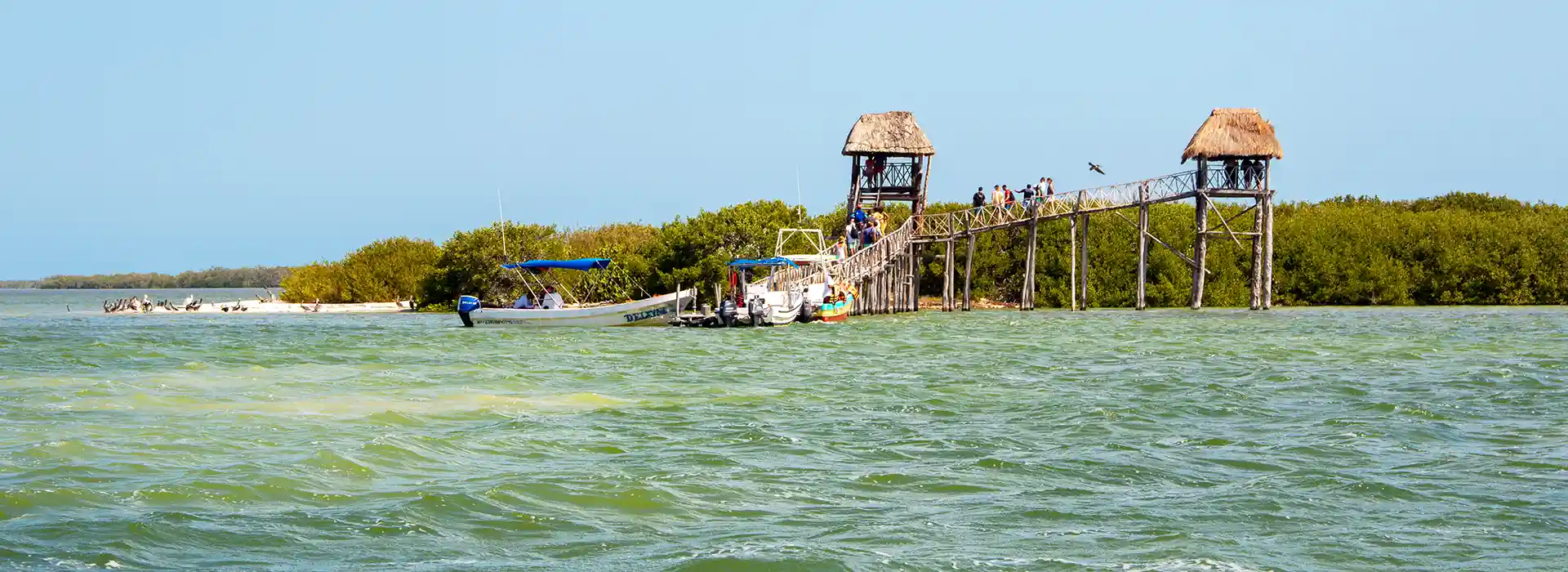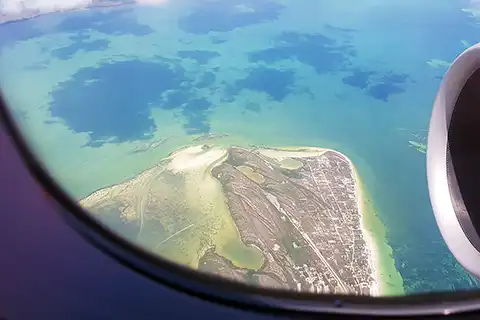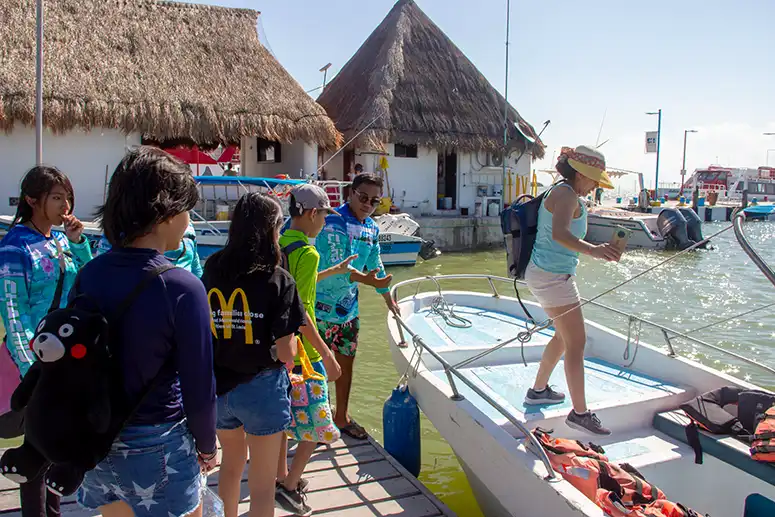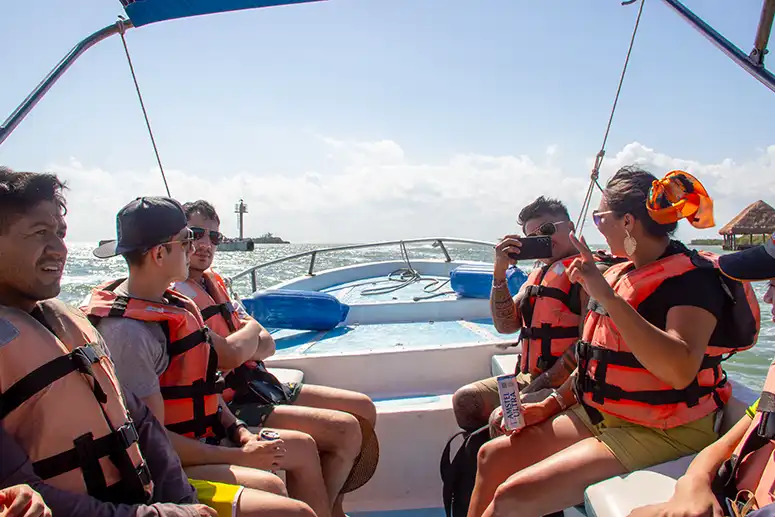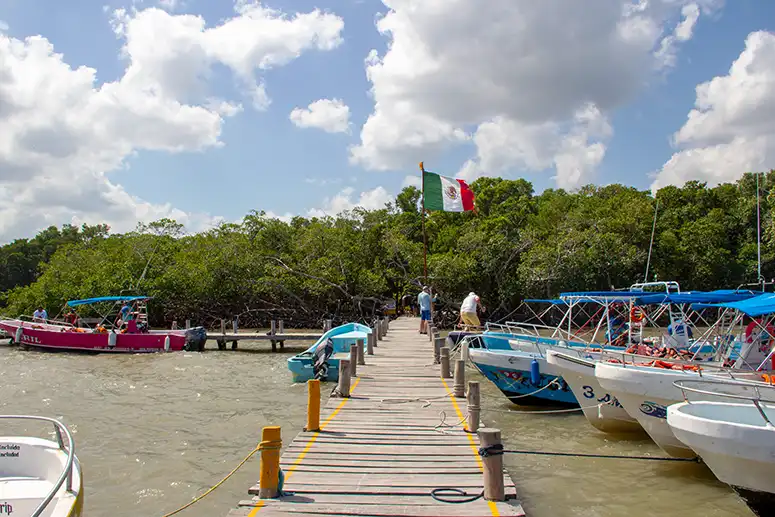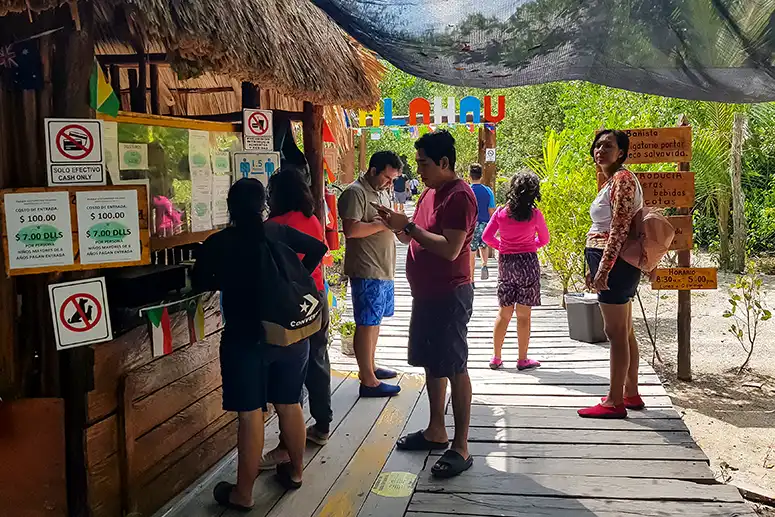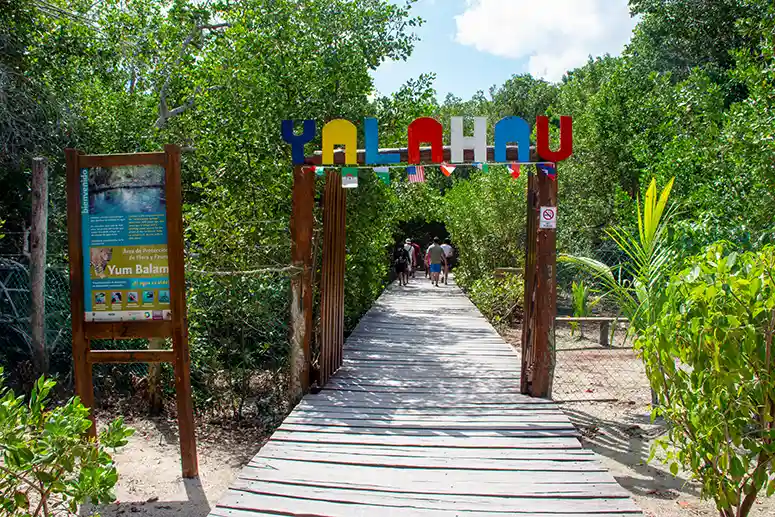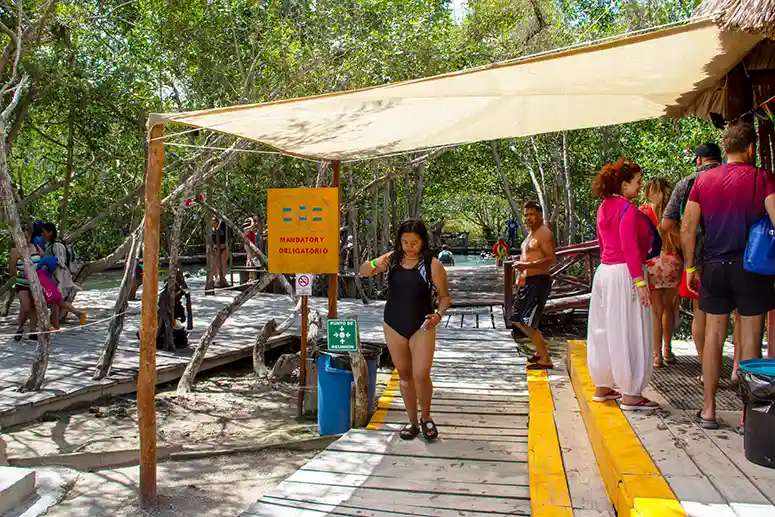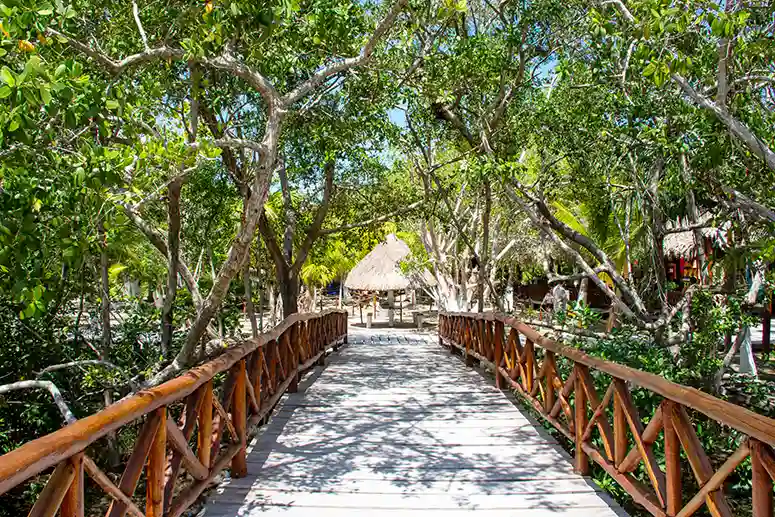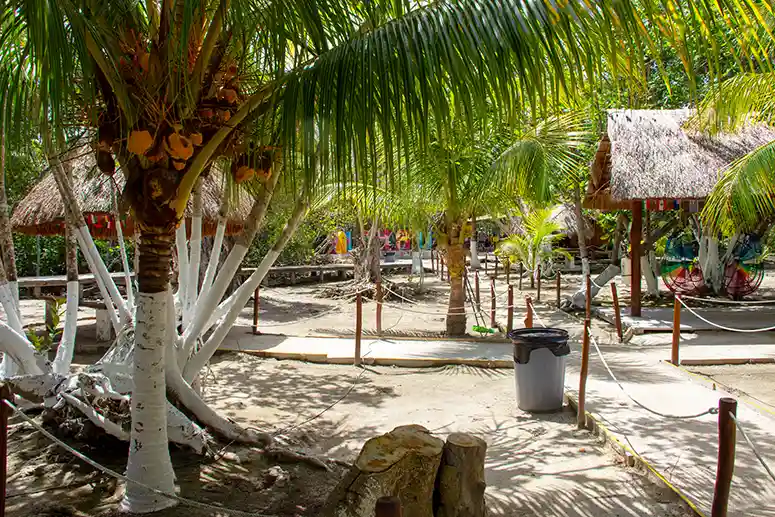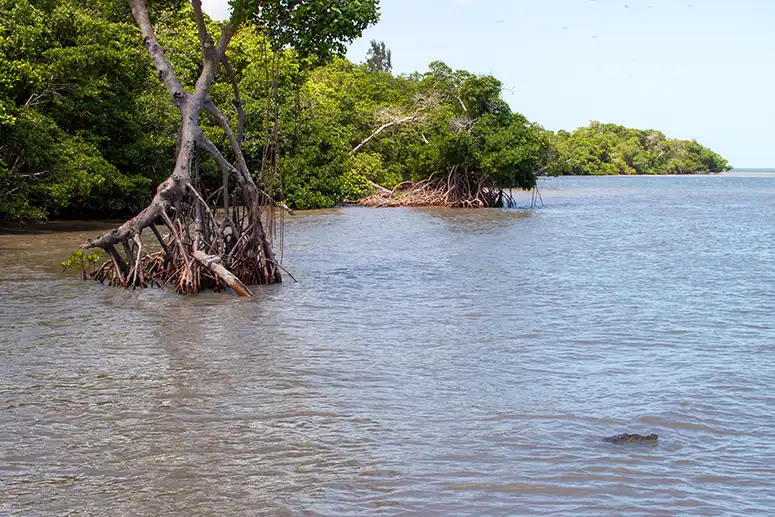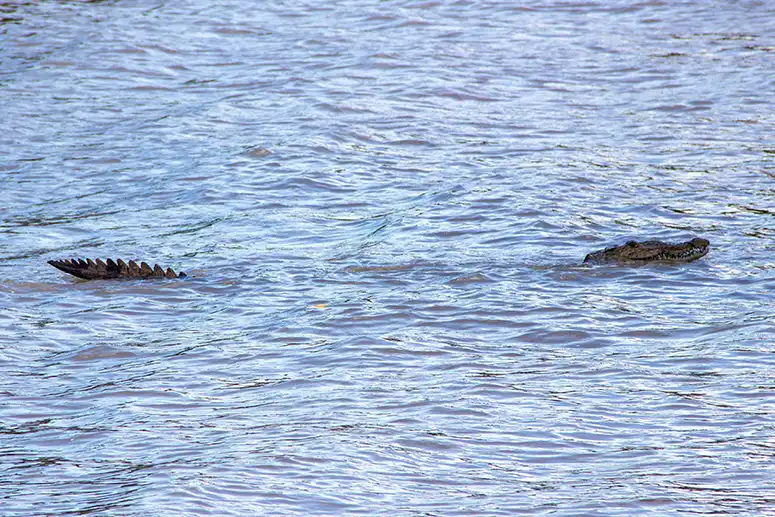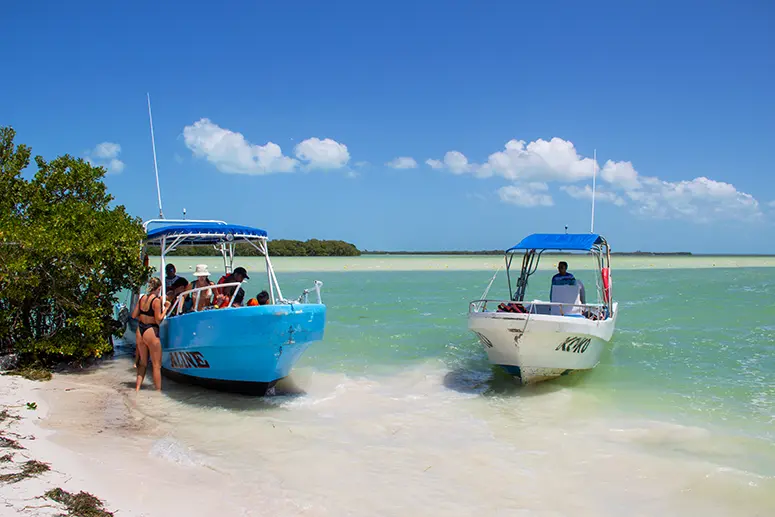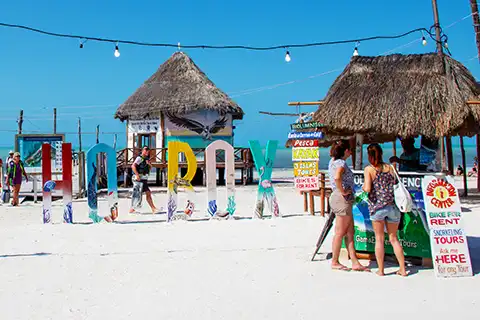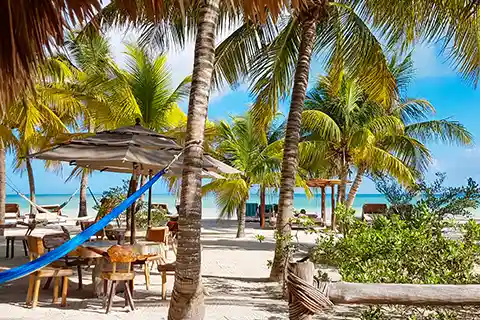The 3 Island Tour Holbox: The Excursion for in Between
A Little Change From The Beach Is a Must
After the first few relaxing days on Isla Holbox, which we spent mostly on the beach, we were already so relaxed that we wanted to do something. Lounging around at the beach club all day, eating at our favorite restaurants in the evening, and then sipping a cocktail or two gets a little monotonous after a while. A Holbox excursion in between would certainly provide some variety.
So in the evening, after some delicious tacos at El Poblano Restaurant, we went for a walk around the main square. We quickly found what we were looking for at the Willy’s Tours booth on Calle Tiburón Ballena. There were still a few places available for the popular 3 Island Tour Holbox the next day. The boat trip takes 3 hours and goes via Isla Pájaros to Cenote Yalahau and finally to Isla Pasión.
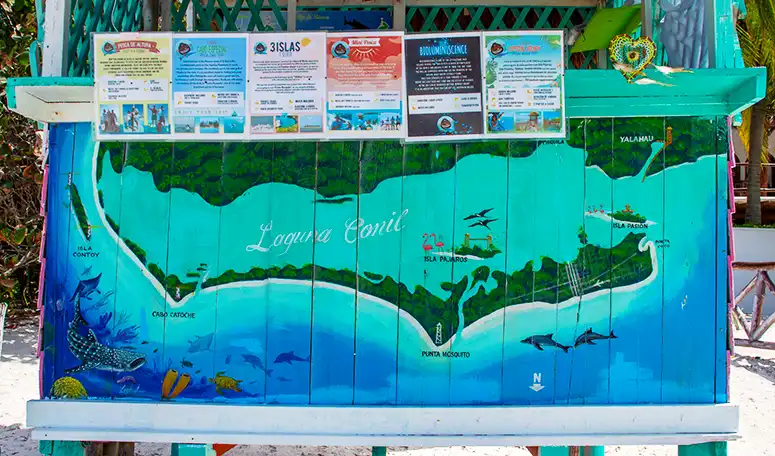
We had done the tour to the three islands many years ago, but were curious to see what had changed in Holbox in the meantime. So we booked the boat tour, for which we paid only 500 MXN (30 USD / 39 CAD / 23 GBP) each, due to the short term availability of seats. Normally the price for the 3 Island Tour Holbox is 750-900 MXN (44-53 USD / 59-70 CAD / 35-42 GBP), depending on the tour operator and service.
Online booking options for the 3 Island Tour Holbox:
Tip: The 3 islands tour takes place twice a day, in the morning and in the afternoon. For more information about this tour and other excursions, visit our page about available tours in Holbox.
Gathering for the Boat Trip
The meeting point for the tour was at 9:50 a.m. the next day at the booth we had booked. A few minutes later a taxi picked us up. The first route took us to the port of Holbox, where the ferries from Chiquilá dock. Other participants were picked up there and distributed to different motorboats. A short time later we left the port with 12 people on board.
First Stop: The Bird Island Isla Pájaros
After a 20-minute boat ride, we were already approaching our first destination of the three-part tour: Isla de los Pájaros, also known as Bird Island. The tiny isle has a diameter of only 500 meters (1,640 ft) and is located about 6 km (3,7 miles) east of the port in the Laguna Conil, which stretches between Isla Holbox and Chiquilá.
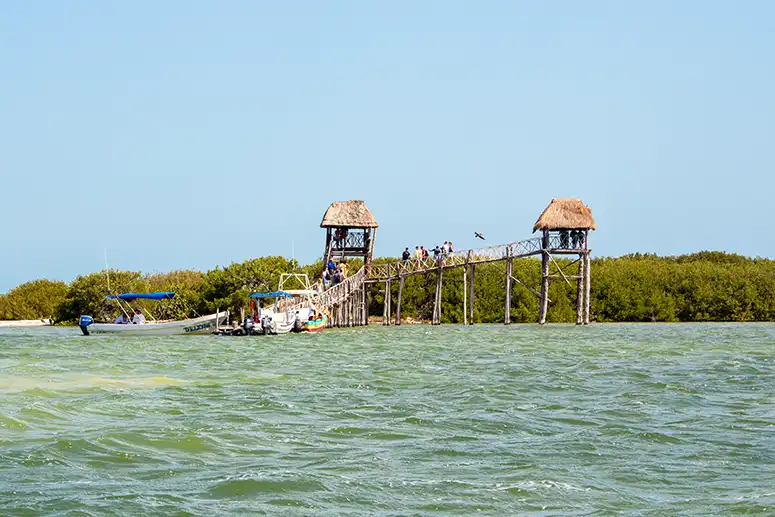
The island itself is not accessible as it is a nature reserve. However, there are two observation towers from which you can get a great view of the diverse bird life. Over 35 species of birds live and nest here, including gray and white pelicans, herons and white ibises. Shy pink flamingos, reddish egrets and roseate spoonbills are less frequent, while frigate birds and cormorants are more common.
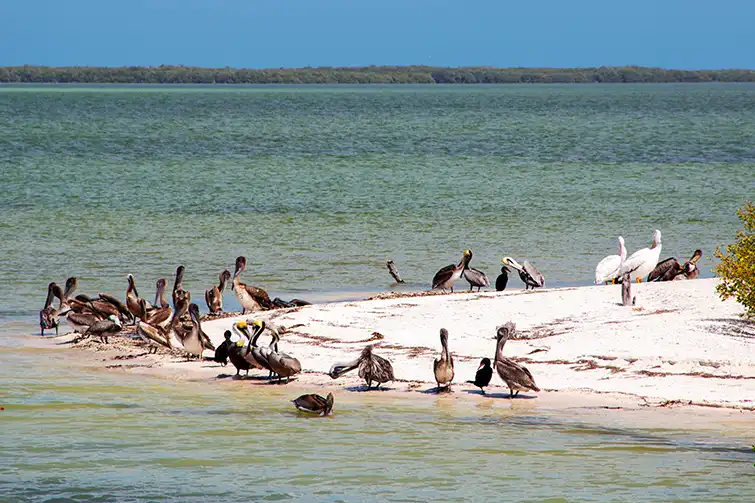
The two observation towers with the footbridges between them are a popular photo motif for tourists. However, you should hurry as soon as you have a halfway clear view, because the stay is only 10 minutes and the next visitors are not long in coming.
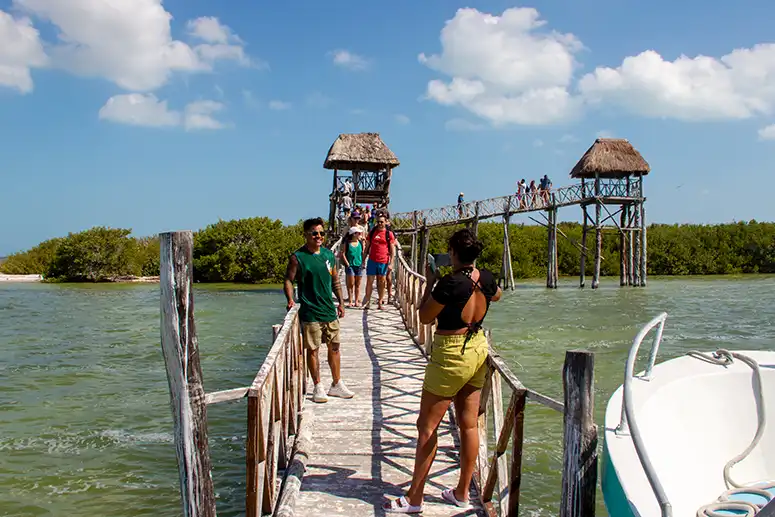
Our captain Miguel explained to us that the birds here are used to human visitors, so they are not disturbed during nesting. We can’t really imagine that with such a crowd. We also remember that there were many more birds on our last visit a few years ago.
On to the Cenote of Yalahau, the Hoyo Negro
The stay on Isla Pájaros was over quickly and so we went to the highlight of the 3 Island Tour Holbox: the Cenote of Yalahau. After a half hour motorboat ride we docked at the jetty in Yalahau where several boats had arrived before us.
Yalahau is actually on the mainland west of Chiquilá, but can only be reached by sea. It is a jungle area surrounded by mangroves with a small cenote that was already known to the Mayas. The clear and cold fresh water of the “Hoyo Negro”, which translates to “Black Hole” as they called it back then, is fed from underground and is a welcome place to cool off.
Immediately after docking at the jetty, the path leads through dense mangrove forest to a wooden hut at the end. There is a small entrance fee of MXN 100 (6 USD / 8 CAD / 5 GBP), which is not included in the tour price.
The trail continues into the interior of the reserve, which is part of the vast Yucatán Biosphere Reserve called Yum Balam. After a few meters the wooden path on stilts branches off to the left to the cenote and to the right to a covered bar with snacks and souvenirs.
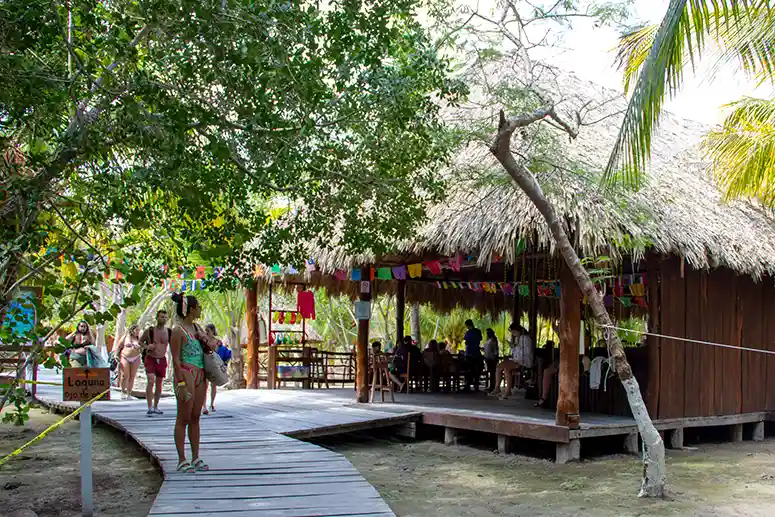
Now it’s time to put on life jackets if you want to swim in the cenote, which almost all visitors do. Directly opposite is a popular photo motif with the colorful lettering of Yalahau, as is common in many tourist places in Mexico.
After putting on the life vest we continue to the pool of the cenote, which is well surrounded by a wooden walkway. A rope is stretched in the middle so that less experienced swimmers can feel safe. At peak times there are quite a few swimmers in the pool, but it is still a good opportunity to cool off in the midday heat. The water in the cenote is crystal clear and actually very cold as it is constantly coming up from underground. There are even a few fish to be seen, which indicates good water quality.
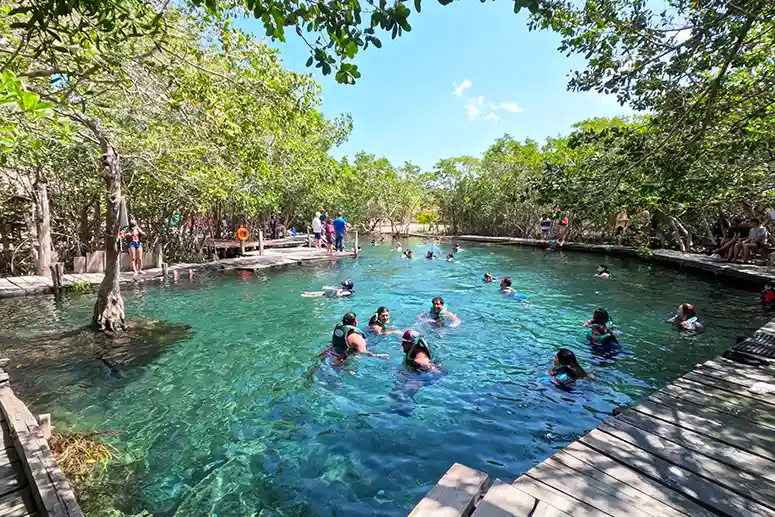
A wooden observation tower is clearly visible from the footbridge surrounding the swimming area of the cenote. You have a wonderful view of the jungle surrounding Yalahau if you climb it.
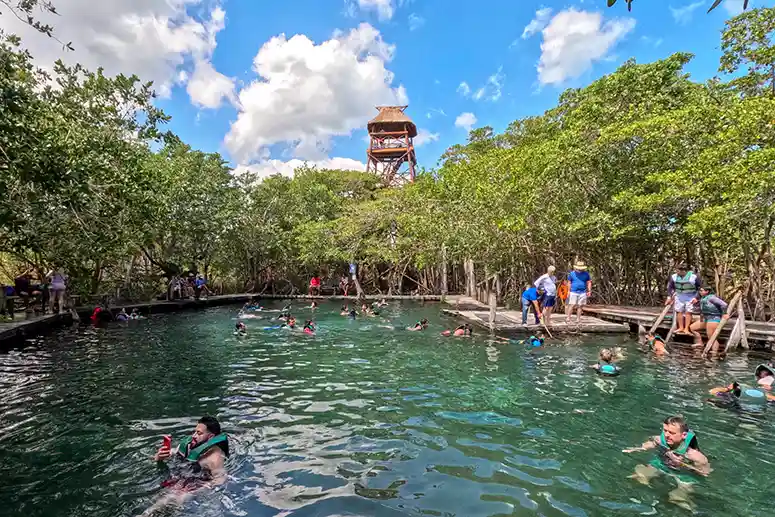
After refreshing yourself in the cool water, it is worth taking a short walk around the property. Although the site has been heavily developed in recent years, it offers a beautiful glimpse into the natural jungle and mangrove world that would otherwise be inaccessible. In general, cenotes in Mexico are fascinating and magical places that were used by the Mayans for various religious rituals.
After a quick cool down and a tour of the park, we made our way back to the dock. Once there, we were in for a surprise.
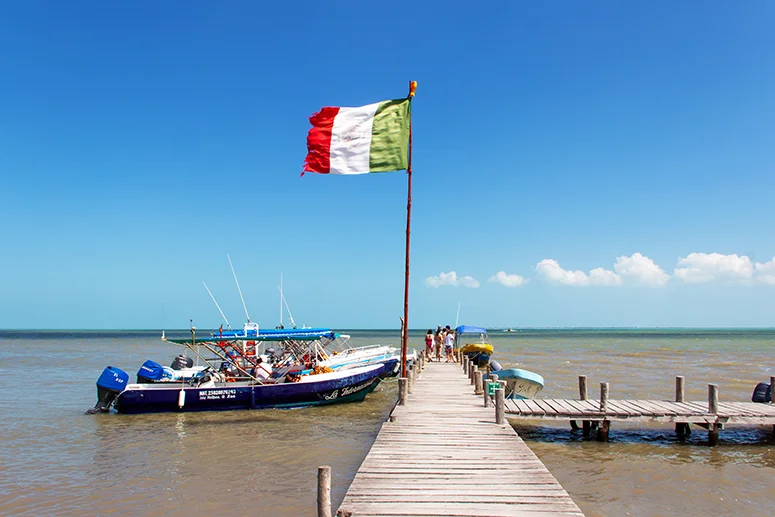
Holbox Crocodiles on the Prowl in Yalahau
Our boat captain was already waiting for the group to show us something urgent. A full-grown crocodile was on the prowl just a few meters from the moored motorboats. It swam out of the mangroves towards the open sea, sometimes revealing its long, spiny tail, sometimes its sharp-toothed mouth, before disappearing for a while.
After a short time, the crocodile returned with a large fish in its mouth. The fearsome reptile kept biting its prey as it retreated back into the mangroves. As it did so, it stuck its mouth out of the water, allowing us to get some good “snapshots”.
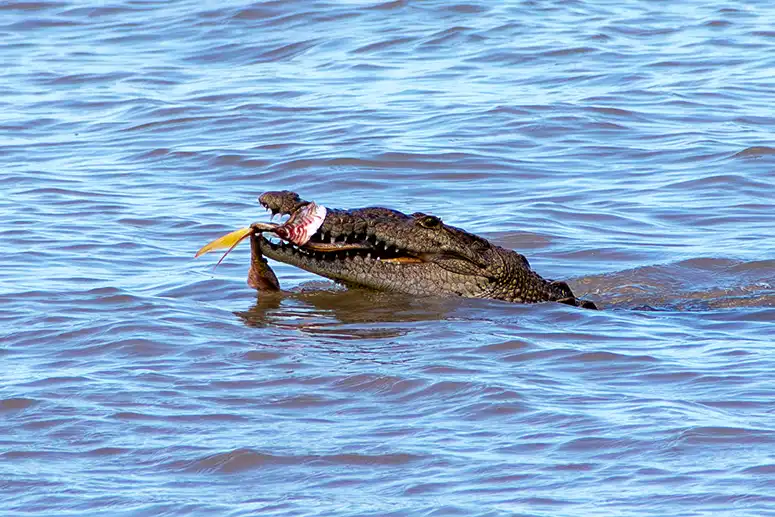
Captain Miguel told us that two Holbox crocodiles had settled in Yalahau some time ago. At the border between the salt water of the sea and the fresh water constantly flowing in from the cenote, many fish seem to gather, providing the crocodiles with an ideal and constantly abundant source of food. This has persuaded them to stay – tourists or not. Tourists need not worry as long as they stay on the designated paths. Fish taste better to crocodiles.
Wading Around the Isla Pasión
After the crocodile disappeared back into the mangroves and the excitement died down, the boat trip continued to Isla de la Pasión, also known as Passion Island. This tiny sandy isle is located near Punta Cocos, southwest of Isla Holbox. If you take a walk along Holbox Beach, you can see it and its lookout tower at the end of the path. You can get even closer by taking a golf cart to Punta Ciricote.
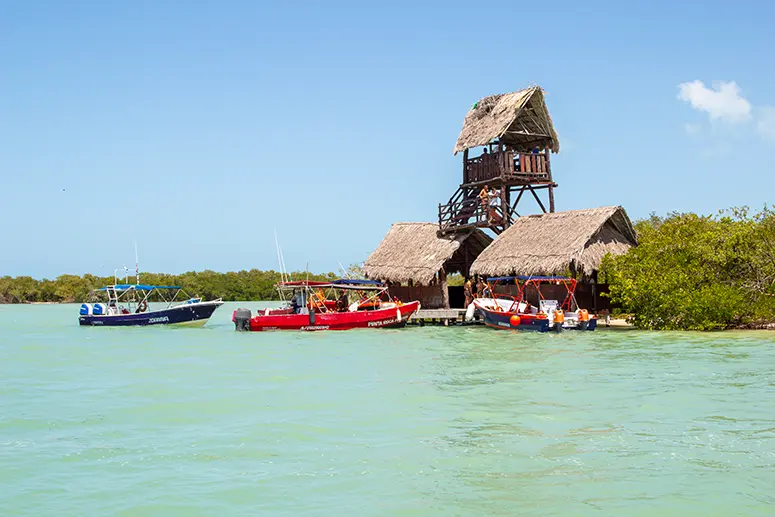
When we arrived, the pier was full. So we went to the other end of the small island, which is only 100 meters (330 ft) in diameter. There we were let out of the boat in knee deep water and told to walk around the island along the beach to the jetty where Captain Miguel would pick us up.
So we did, because you can’t go inside the island anyway, because it’s overgrown with bushes and mangroves. Near the jetty there is a shaky looking lookout tower with two shady extensions. From the top you have a wonderful view of Isla Holbox.
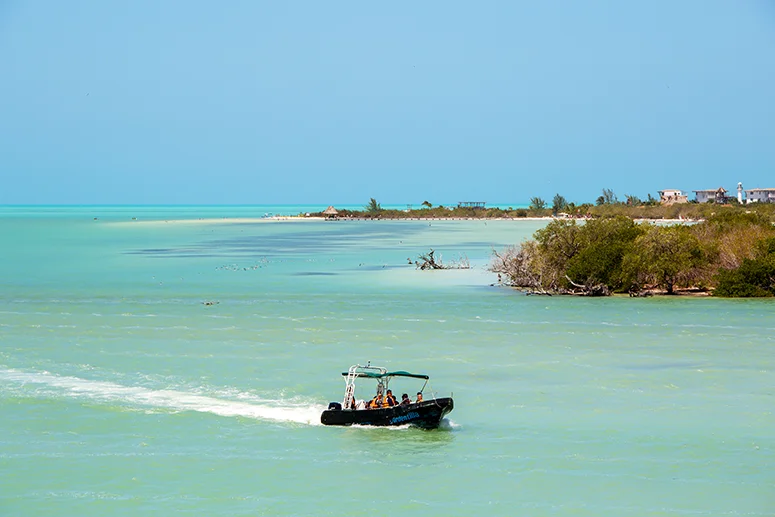
There used to be a turtle hatchery on Isla Pasión. Unfortunately, there is nothing left of it except for a dilapidated hut that can be seen from the tower. After about 20 minutes of wading in the shallow water around the island and enjoying the beautiful view from the tower, Captain Miguel brought us back to the port of Holbox. The tour took a total of 3.5 hours and was a welcome change with a surprise factor.
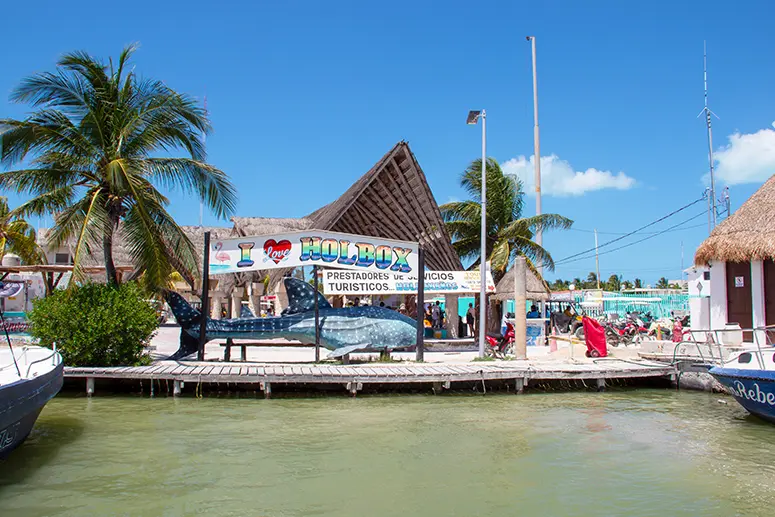
Our Conclusion to the 3 Island Tour Holbox
The 3 Island Tour Holbox is the classic tour for vacationers on Isla Holbox and is popular with many tourists, so you can expect to meet a lot of like-minded people. It is comparatively cheap and in 3-4 hours you get a boat ride, some nice impressions of the fascinating nature of the Yucatán and the opportunity for a cool bath in the Cenote of Yalahau. This Holbox excursion is definitely worth the money and can be booked with any operator.
However, you should not expect too much background information and explanations, as the tour is usually conducted without a guide and only by the boat captain, who may say a few words in English at each stop, depending on his language skills. A private tour, which can be booked individually and away from the crowds, offers a much more intense experience with interesting background information.
More about excursions and tours:

